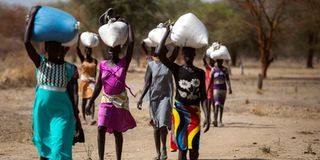Breaking News: Old Kijabe dam tragedy: Death toll rises to 45
Irony of hunger amid plenty a joke even witches reject

Women carry food in gunny bags after visiting an aid distribution centre in Ngop in South Sudan's Unity State on March 10, 2017.
What you need to know:
- Tanzania can easily feed itself and supplement food supplies in the East African region.
- Some farmers in the Mpui region of Songea can harvest as much as 40 bags of 90-kg maize by deploying interventions like using the right inputs in the correct quantities at the right time and improving post-harvest handling to reduce losses
Everyone I told that I was in the Sumbawanga region of south-western Tanzania this past week responded with one or another joke about the region’s notoriety for witchcraft. From wisecracks that mine was a surreptitious visit to secure some election-winning concoction in readiness for next year, to giggles that I watch out for apparitions and ghostly conversations in and around my hotel room, I heard it all.
So I asked my hosts why this rather dubious heritage. The anecdote I got was that yes, the region some time back hosted some of the most potent conjurers of the arts of witches and wizards and although there existed equally accomplished diviners (the waganga in Kiswahili), the latter’s exploits were easily dwarfed.
Killer concoctions
But it seems like the ordained inheritors of the art of night-running and creating killer concoctions refused to receive the gifts from their fathers and that, combined with immigration of other communities into the luscious and rich agricultural lands, suffocated the art. There probably also was an official campaign to reduce or eradicate the practice for the name Sumbawanga means tupa (sumba) uchawi (wanga), that is Kiswahili for discard witchcraft.
What is there now is this laid-back town planned in rectangular shapes with streets crisscrossing and fronting small shops and eateries that don’t rise beyond the ground.
The nicely done road from Tunduma (at the Zambia/Tanzania border town) you are periodically reminded was built through the generosity of the American taxpayer and ends at Sumbawanga but the road continues towards the western town of Mpanda.
Beyond the town and indeed as far as the eye can see is a beautiful green canopy, interrupted by hills and covered by various crops – mainly maize and rice but with potential to support anything.
So vast is this area and so productive that it is depressing that global and regional agencies concerned about food security and promoting good agricultural practices are reporting close to 200 million people in Africa facing food insecurity.
The AGRA Monthly Food Monitor Report for March notes many African countries showed increased numbers of people confronting insufficient food consumption. Surprisingly, in that list is Tanzania at 9 per cent of its population.
Kenya, Uganda and Rwanda may not be on that list but it does not mean that they do not have food-insecure people. Situations in countries like Ethiopia, Somalia and South Sudan with ongoing internal conflicts are even more perilous.
As this is not a new situation – Covid-19 is the only factor being added to the usual suspects of political instability and climate stress. The challenges can be resolved with real political commitment inside the countries and at the regional level. Tanzania can easily feed itself and supplement food supplies in the East African region.
Some farmers in the Mpui region of Songea can harvest as much as 40 bags of 90-kg maize by deploying interventions like using the right inputs in the correct quantities at the right time and improving post-harvest handling to reduce losses. These results achieved on projects driven by governments and supported by partners like the pan-African Partnership for Inclusive Agricultural Transformation in Africa (PIATA), and involvement of the private sector, can be replicated across the region.
These interventions are increasingly being complemented by introduction of regenerative and climate-smart agricultural technologies such as minimum tillage of land, cover cropping, intercropping (use of legumes), crop rotation, composting, use of organic mulch, agroforestry, the use of certified stress/drought-tolerant crop varieties and seeds, and soil and water conservation technologies such as terraces and basins. These enhance soil fertility and protect the environment while increasing yields.
Diminishing returns
There is certainly no justifiable reason farmers in the traditional maize-growing areas of Kenya’s North Rift should be seeing diminishing returns when they can reverse this with inexpensive interventions. Governments must really start governing and budgeting resources for the benefit of the people while paying more than lip service to the regional and continental commitments that they have committed to.
For the East African governments to fight over whether maize should be allowed to cross borders to feed their people, rather than spend time and energy to look at the opportunity offered by, for example, the African Continental Free Trade Area, is to behave like dangerous sleepwalkers under the spell of long gone Sumbawanga witches.
[email protected], @tmshindi





